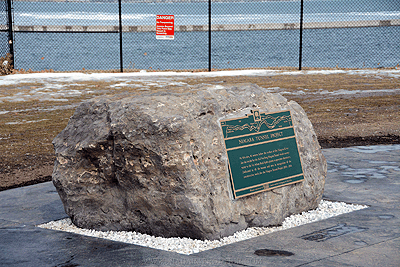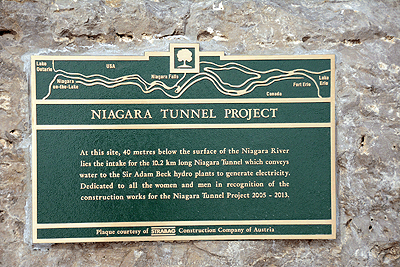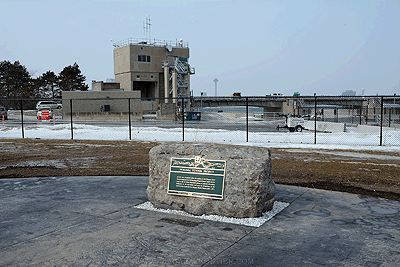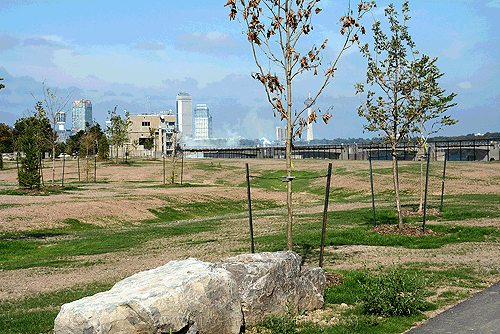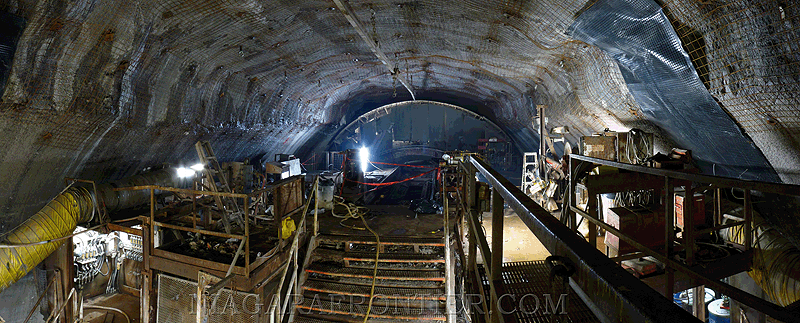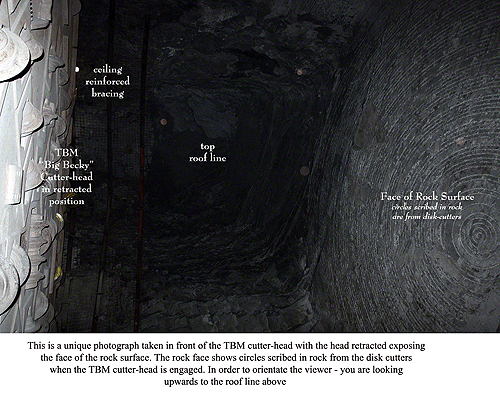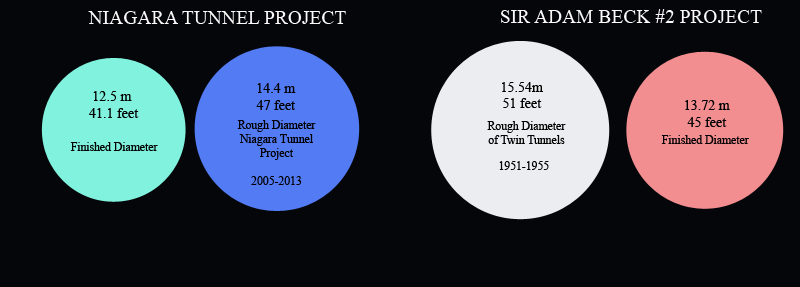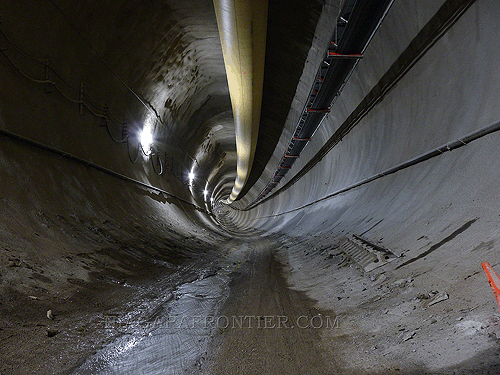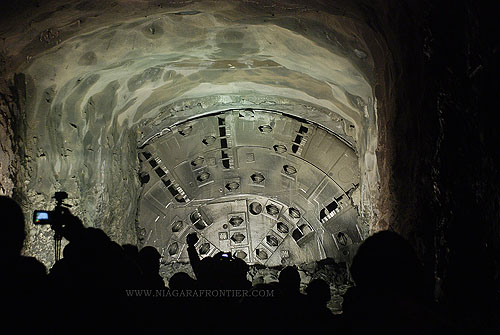Niagara Tunnel named "Canadian Project of the Year" by the Tunnelling Association of Canada
At a gala dinner awards
ceremony in Vancouver on Friday evening, TAC President Rick Lovat
announced the awards that were introduced by a video summary and
presented by officials of the TAC executive committee. Canadian
project of the year for 2013 was announced as the Niagara water
delivery tunnel for Ontario Power Generation that came on line to
increase hydropower generation at the Sir Adam Beck installation on
the Canadian side of the Niagara River in March 2013. As a marker in
the history of international underground construction, the Niagara
Tunnel Project is recognized for overcoming its many challenges and
difficulties and for the several firsts achieved by its design and
construction. As well as being excavated by the largest hard rock
gripper TBM to date at 14.4m diameter, the tunnel is lined with the
largest diameter pre-stressed in-situ concrete lining ever. Started
in August 2006, excavation of the 10km long tunnel was completed
finally in March 2011.
In accepting the Canada project of the year award, Rick Everdell,
Project Director for owner Ontario Power Generation (OPG); John Tait,
Project Manager for Hatch Mott MacDonald, OPG's representative, in
association with Hatch, on the project; and Oskar Roittner, Project
Director for Strabag, the contractor; each explained the geological
difficulties encountered, the contractual strains faced as time and
costs increased and the tremendous efforts expended, and by The
Robbins Company also as supplier of the record 14.4m diameter hard
rock TBM, in keeping the project on track and push towards the
successful completion.
Tunnelling Association of Canada
October 31st 2013 -
Strabag will have completed their contractual obligation to OPG in the building of the Niagara Tunnel. Strabag staff will move from their outlet headquarters on October 28th and will continue to maintain a Canadian/North American office in Mississauga, Ontario. The trailer complex used as the main offices of Strabag at the outlet site has been sold by auction and will be removed from the site on or before November 20th 2013. The intake work assembly site (located on the west side of the Niagara Parkway) has been turned over to the Niagara Parks Commission.
Strabag has asked the Niagara Parks Commission to approve and erect the placement of a commemorative plaque at the Niagara Tunnel Project intake area with wording as follows:
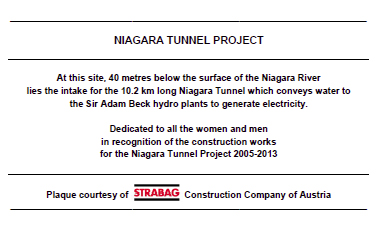
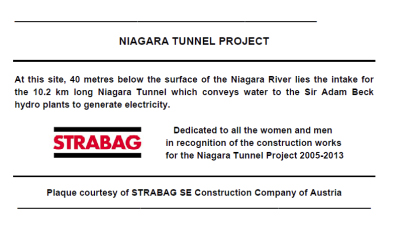
As in many projects of this magnitude in Europe and in North America, a plaque is erected to commemorate the project and honour the men and women constructors. This particular project is no exception and Strabag SE is requesting to place a bronze plaque at the intake area of the tunnel. The plaque will be similar to the 70 or so plaques along the Niagara River Recreation Trail and not unlike another bronze plaque in the area dedicated to the construction of the original Ontario Hydro tunnels built in in 1950.
Niagara Parks staff recommended to Strabag
SE, a slightly more informative plaque without the large red STRABAG logo,
however the company wishes to present to the Commission the plaque as shown. A
more detailed plaque regarding construction of the tunnel is scheduled to be
placed on City of Niagara Falls lands at the intersection of Thorold Stone Road
and Stanley Avenue.
Strabag SE wishes to have a dedication / unveiling of the plaque in November
2013.
A Panoramic of the Outlet Channel - October 15th 2013
Reclaimed Niagara Tunnel Intake Site - September 19th 2013
Niagara Tunnel Outlet Site - September 17th 2013
Niagara Tunnel Outlet Site - September 17th 2013
September 17th 2013 -
The project continues to wind down quickly.
The intake site has been reclaimed and landscaped to include a bicycle/pedestrian path along the rivers edge. Strabag has returned the intake site to the Niagara Parks Commission. The parking lot next to the International Water Control Works has been returned to OPG. The properties were returned to their respective owners at the end of August 2013. The OPG parking lot nearest the Niagara Tunnel intake remains reinforced with a concrete base sufficient to support a crane of a size and weight capable of lifting and dropping the stop-log gates into place in order to stop the flow of water into the tunnel in case of an emergency. The stop-logs and their respective gantries are being stored at the outlet site.
The intake site work yard on the opposite site of the road continues to be cleaned before being returned to the Niagara Parks Commission. The Robbins Company is currently working to dismantle the TBM main-frame and main bearing for removal purposes. The cutterhead is all but a memory. Most parts were reclaimed for scrap while several stripped down pieces are being stored off-site pending a decision as to whether or not they will be placed along the City of Niagara Falls Millennium Trail (as yet to be developed north of Thorold Stone Road).
The Niagara Parks Commission is giving thought to establishing their greenhouse facilities at the former intake works yard.
The outlet site is undergoing final grading before being returned to OPG on or before October 31st 2013.
The current Strabag staff compliment include 5 HQ members, eight workmen and three security staff. It is anticipated that Strabag will be moving off of the outlet site by mid-October to their new Canadian Headquarters in Mississauga, Ontario. This will mark the end of this massive project.
A water flow test to determine the flow capacity through the Niagara Tunnel was conducted in June 2013. Although the final report has not been published, the tunnel did meet or exceed the design specifications of 500 m3/s, +/-2%.
Niagara Tunnel Intake Site - August 16th 2013
July 17th 2013 -
International Water Power & Dam Construction has declared the "North American Project of the Year" - The Niagara Tunnel Project
In March 2013, after eight years of tireless work, the largest hydroelectric project in Ontario in the past 50 years came to completion to the cheers of hundreds of onlookers. The new 10.2km tunnel is now channeling additional water from the Niagara River to Ontario Power Generation's (OPG) Sir Adam Beck Generation Station, with the water travelling at a rate of 500m3/sec. The tunnel delivers enough water to increase average annual energy output by 1.6BkWhr - enough to supply 160,000 Ontario homes with clean, renewable hydroelectric power.
Ontario is rapidly emerging as an international hub for developing innovative clean tech solutions and delivering them to markets worldwide. The Niagara Tunnel Project, which was built at a cost of $1.6B, is part of Ontario's long-term energy plan to produce and use clean and renewable sources of energy including wind, water, solar, biomass and biogas. Today, more than 80% of electricity generated in Ontario comes from these clean energy sources, and by the end of 2013 Ontario will close down its last two coal plants in southern Ontario - a full year ahead of schedule.
But it's not just about power generation. The province recently completed a $1B rollout of 4.7 million smart meters - one of the largest smart grid deployments in North America - and is now investing nearly $2B to further improve its smart grid infrastructure.
Like Ontario's long-term energy strategy, the Niagara Tunnel project is ambitious in every way: in physical scope and technical complexity - the tunnel has a world record-breaking diameter of more than 14m, almost twice the diameter of the Euro Channel Tunnels. Austrian firm Strabag SE was hired as the design-build contractor and engineering firm Hatch Mott MacDonald Ltd. provided technical and management oversight. Robbins, a manufacturer of underground construction machinery, was contracted to build the world's largest hard-rock tunnel boring machine for the project. Fully assembled, the 4,000-tonne Big Becky - nicknamed by local school children - measured an impressive 150m long and 14.4m high, as tall as a four-storey building. To bore its way from the tunnel's outlet to the intake at the other end, Big Becky was required to bore through more than 1.7Mm3 of rock. Its 85 disk cutters could cut through about 2.5m of hard rock per hour.
Construction at the outlet began in September 2005. Six months later, Strabag and its subcontractors started working at the intake, located near International Niagara Control Works, part of the system that controls the volume and flow of water over the Horseshoe and American Falls. Then Big Becky started drilling in September 2006.
The project has provided employment and about $1B in economic benefits to the Niagara region. At its peak almost 600 people were employed directly on the project. But as might be expected with an undertaking of this magnitude and complexity, there have been a number of challenges along the way.
Machine and crew faced difficult ground conditions, characterized by high in situ pressure, swelling rock, aggressive groundwater, and steep grades at either end of the tunnel. To address overbreak problems with the Queenston Shale rock formation surrounding sections of the tunnel, OPG realigned part of the tunnel and reduced its length by about 200m.
After Big Becky pushed through to the intake end of the
tunnel in May 2011, the crew moved on to Phase II of the
project, which involved installation of a waterproof
membrane and about 400,000m3 of cast-in-place
concrete lining.
Some people have wondered if the Niagara Tunnel might affect
the water flow over the Horseshoe Falls. The 1950 Niagara
River Water Diversion Treaty stipulates the minimum flow
over the falls for scenic purposes therefore the scenic flow
commitment will not change. However, when the tunnel is in
service, power flow available to Canada will exceed OPG's
diversion capability less than 15% of the time.
With the Niagara Tunnel complete, Ontario has moved one step closer to its goal of generating 9,000 megawatts of hydro power by 2018 and creating a diverse and reliable supply of clean, renewable energy for Ontarians. This is a significant provincial achievement and one that will provide Ontario with a source of clean energy for the next 100 years. - article by Water Power Magazine
Niagara Tunnel Intake Site - July 9th 2013
Paving the bicycle/pedestrian path along the intake site -
June 26th 2013
June 8th 2013 -
The cutterhead monument was scrapped due to liabilities of having a 40' high rusty steel structure erected in a public place. The City of Niagara Falls has expressed an interest in erecting a few smaller pieces along the Millenium Trail, so the cutterhead may be on public display after all.
Ontario Power Generation will keep select pieces of the cutterhead that are being stored by OPG until a final location is determined for a future public display.
May 31st 2013 -
Ontario Power Generation will be hosting a used equipment auction at the Outlet office site on June 17th & 18th. Ritchie Brothers Auctioneers.
May 14th 2013 -
Ontario Power Generation will be hosting a used equipment auction at the Outlet office site on June 17th & 18th.
The final flow test will take place in June 2013.
The plan to re-erect the entire cutter-head or a portion thereof from the TBM "Big Becky" in the small park under construction at the Intake site as a lasting memorial to the Niagara Tunnel Tunnel Project highlighting the engineering feats of many contributing companies and the workers has been removed from the original plans. Unless Strabag, OPG, the city of Niagara Falls and the Niagara Parks Commission come to an agreement in the 11th hour, it would appear that the iconic cutter-head is destined to be returned to the Robbins Company for scrap. The largest single construction project in Niagara of this generation and any related tourism opportunities are destined to fade into the memories of those members that have planned, engineered and toiled to build the Niagara Tunnel. Apparently talk is cheap.
Strabag will have completed the Intake site on or before August 31st 2013. At that time the Intake area will be returned to OPG and the Niagara Parks.
The Health & Safety Components of Strabag, Hatch Mott-MacDonald and OPG accomplished a remarkable and admirable safety record during the construction of this massive tunnel. There were NO fatalities and few serious injuries recorded.
* all depth (elevation) measurements are based upon a base of "above sea level"
INDEX
Progress to Date/Current Location
Niagara Tunnel Breakthrough Ceremony
Introduction
Robbins Company
Castonguay Blasting Company Limited
McNally International Construction & Marine Company
Dufferin Construction
Morrison Hershfield Consulting Engineers
ILF
Consulting Engineers
Bermingham
Construction
Company
Strabag Organization Chart - Niagara Tunnel Project
Niagara Tunnel Project - Technical Facts
Niagara Tunnel Project - Vehicles, Carriers & Bridges
Niagara Tunnel Project - Chronology of Events
Voices From The Niagara Tunnel - A Living History
Strata of the Niagara Gorge Chart
Niagara River & Water Diversion
Need For The New Niagara Tunnel
Ontario Power Generation - Quarterly Reports
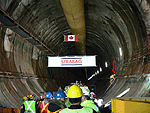
The St. Barbara Ceremony held inside the Niagara Tunnel on December 4th
2008
The red arrow points to the size of an average man in stark comparison
to the immense size of the tunnel
On Friday June 25th 2004, the Ontario Government announced that Ontario Power Generation has been given approval to proceed with the 3rd tunnel under the City of Niagara Falls.
The first two tunnels were built during the 1950's.
On Thursday August 18th 2005, Ontario Power Generation (OPG) announced the selection of the Austrian - STRABAG AG COMPANY to build the $600 million dollar hydro tunnel. The 10.4 kilometer (6.4 miles) water tunnel will run under the City of Niagara Falls from the upper Niagara River to the Sir Adam Beck Power Stations at Queenston at a maximum depth of 140 meters (459 feet). This third tunnel project is expected to be one of the largest tunnels built in North America.
The new tunnel will parallel the existing water tunnels but at a lower depth. The existing tunnels reach a maximum depth of 100 meters (328 feet).
On Wednesday September 14th 2005, the official ground breaking ceremonies were held to announce the beginning of this massive project.
Currently, Sir Adam Beck Power Group generates 2,080 megawatts. Approximately 1,800 cubic meters (63,566 cubic feet) of water per second from the existing twin tunnels and the hydro canal supply the Sir Adam Beck Stations. The new tunnel will divert an additional 500 cubic meters (17,657 cubic feet) of water per second.
Strabag AG will also undertake remedial work on the former Ontario Power Station, the Ontario Power Station Water Intake Gate House and the former Toronto Power Station increasing the contract cost to $985 million dollars.
The project has now been projected to be completed in 2012 or 2013 from the initial date of 2009.




